Analysis of Leadership and Innovation at Uber Technologies Inc.
VerifiedAdded on 2021/04/21
|12
|3041
|93
Report
AI Summary
This report provides a comprehensive analysis of Uber Technologies Inc., examining its internal and external environments. It begins with an overview of Uber's services and revenue, followed by a SWOT and Porter's Five Forces analysis to identify strengths, weaknesses, opportunities, and threats, as well as competitive dynamics within the ride-sharing industry. The report then delves into the leadership challenges faced by Uber, including communication issues, ineffective change management, and stakeholder management problems. It proposes solutions such as transformational leadership and delegation to address these challenges. Furthermore, the report discusses innovation challenges, such as application updates and transactional costs, suggesting strategies to eliminate these costs and leverage collaborative consumption. The report concludes with recommendations for Uber, including market penetration strategies and technology implementation, along with practical steps for improving leadership and innovation within the company. The report emphasizes the importance of human resource management and continuous innovation for Uber's success.

Running head: MANAGEMENT
Management
Name of the Student
Name of the University
Author note
Management
Name of the Student
Name of the University
Author note
Paraphrase This Document
Need a fresh take? Get an instant paraphrase of this document with our AI Paraphraser
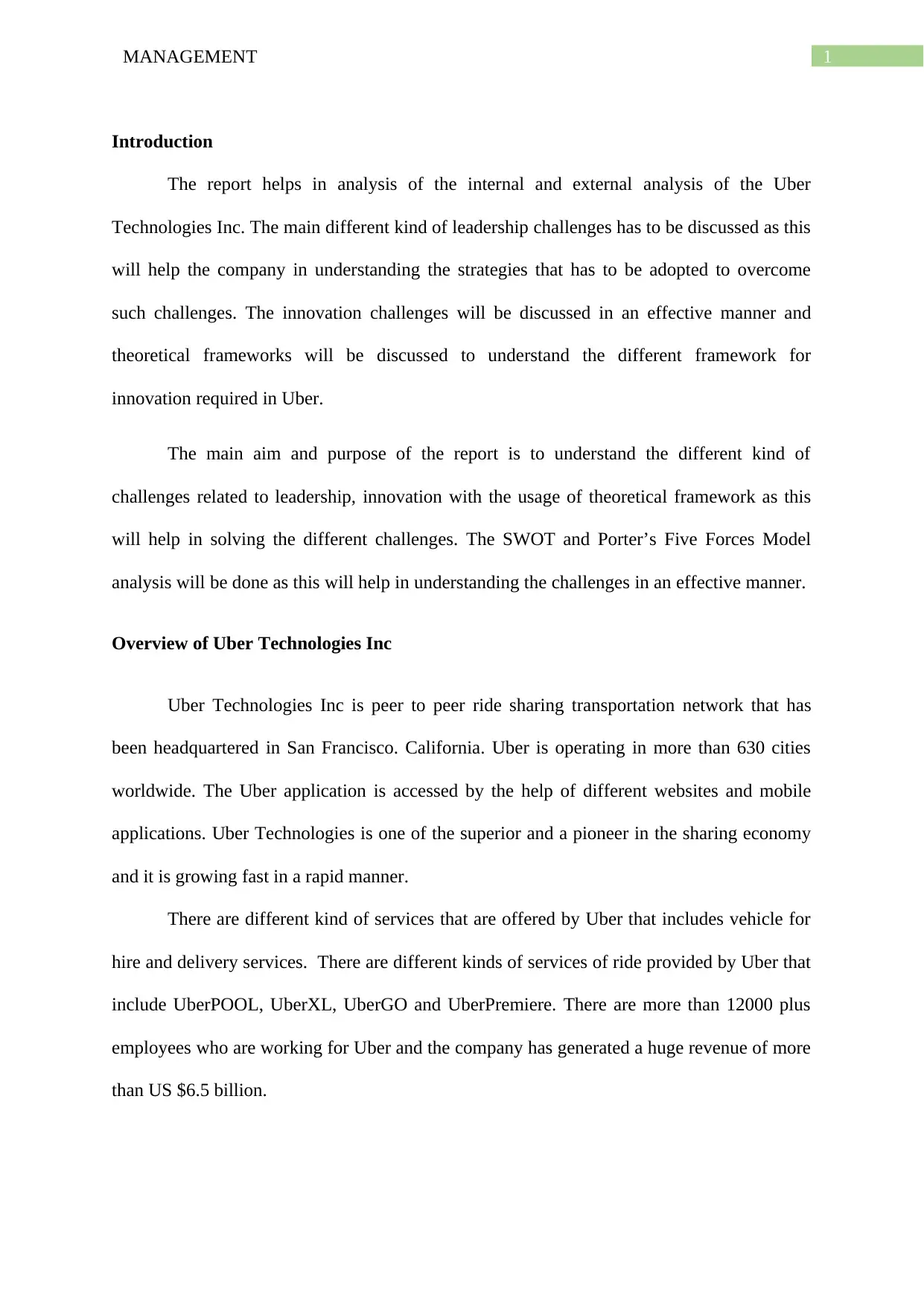
1MANAGEMENT
Introduction
The report helps in analysis of the internal and external analysis of the Uber
Technologies Inc. The main different kind of leadership challenges has to be discussed as this
will help the company in understanding the strategies that has to be adopted to overcome
such challenges. The innovation challenges will be discussed in an effective manner and
theoretical frameworks will be discussed to understand the different framework for
innovation required in Uber.
The main aim and purpose of the report is to understand the different kind of
challenges related to leadership, innovation with the usage of theoretical framework as this
will help in solving the different challenges. The SWOT and Porter’s Five Forces Model
analysis will be done as this will help in understanding the challenges in an effective manner.
Overview of Uber Technologies Inc
Uber Technologies Inc is peer to peer ride sharing transportation network that has
been headquartered in San Francisco. California. Uber is operating in more than 630 cities
worldwide. The Uber application is accessed by the help of different websites and mobile
applications. Uber Technologies is one of the superior and a pioneer in the sharing economy
and it is growing fast in a rapid manner.
There are different kind of services that are offered by Uber that includes vehicle for
hire and delivery services. There are different kinds of services of ride provided by Uber that
include UberPOOL, UberXL, UberGO and UberPremiere. There are more than 12000 plus
employees who are working for Uber and the company has generated a huge revenue of more
than US $6.5 billion.
Introduction
The report helps in analysis of the internal and external analysis of the Uber
Technologies Inc. The main different kind of leadership challenges has to be discussed as this
will help the company in understanding the strategies that has to be adopted to overcome
such challenges. The innovation challenges will be discussed in an effective manner and
theoretical frameworks will be discussed to understand the different framework for
innovation required in Uber.
The main aim and purpose of the report is to understand the different kind of
challenges related to leadership, innovation with the usage of theoretical framework as this
will help in solving the different challenges. The SWOT and Porter’s Five Forces Model
analysis will be done as this will help in understanding the challenges in an effective manner.
Overview of Uber Technologies Inc
Uber Technologies Inc is peer to peer ride sharing transportation network that has
been headquartered in San Francisco. California. Uber is operating in more than 630 cities
worldwide. The Uber application is accessed by the help of different websites and mobile
applications. Uber Technologies is one of the superior and a pioneer in the sharing economy
and it is growing fast in a rapid manner.
There are different kind of services that are offered by Uber that includes vehicle for
hire and delivery services. There are different kinds of services of ride provided by Uber that
include UberPOOL, UberXL, UberGO and UberPremiere. There are more than 12000 plus
employees who are working for Uber and the company has generated a huge revenue of more
than US $6.5 billion.
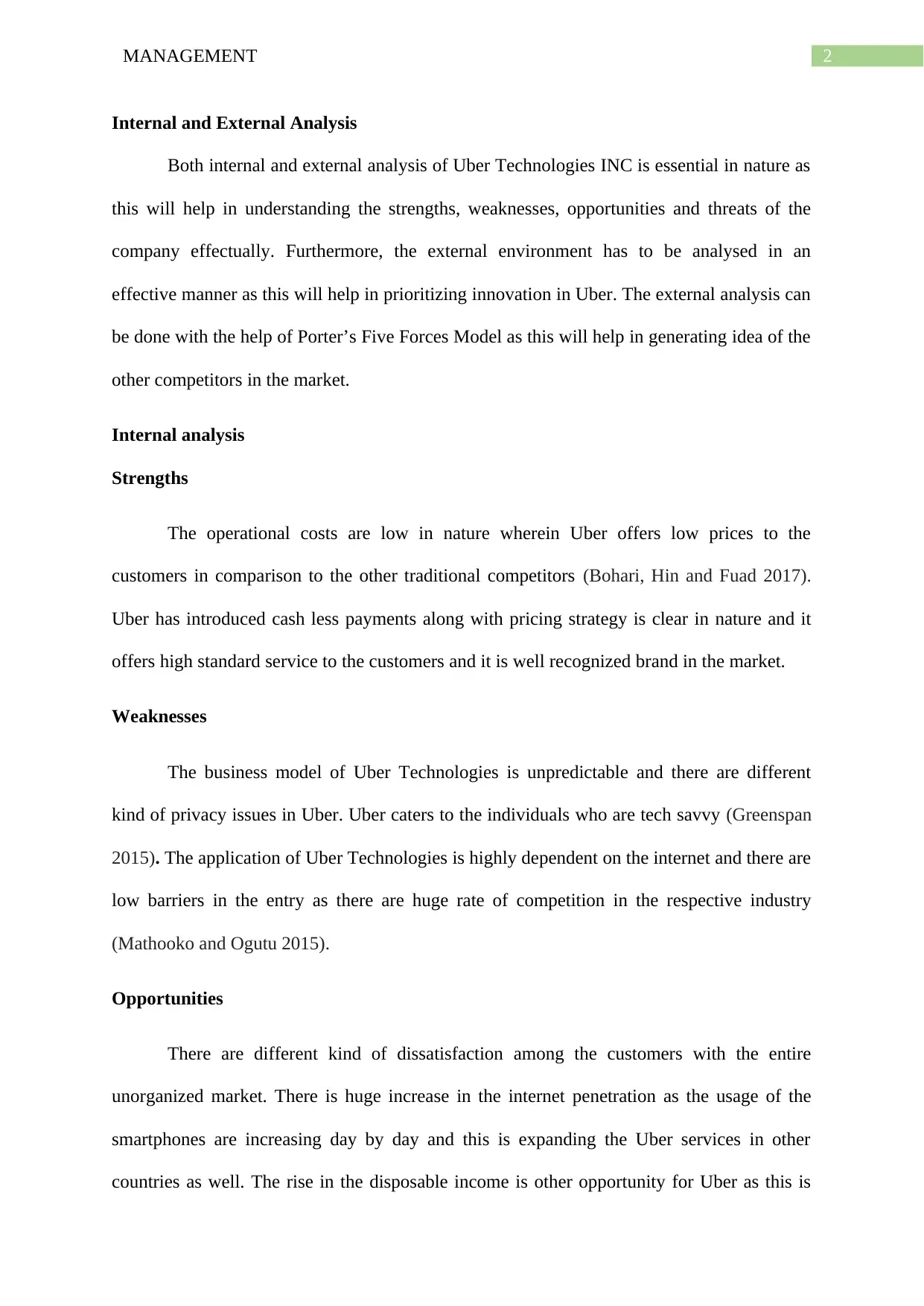
2MANAGEMENT
Internal and External Analysis
Both internal and external analysis of Uber Technologies INC is essential in nature as
this will help in understanding the strengths, weaknesses, opportunities and threats of the
company effectually. Furthermore, the external environment has to be analysed in an
effective manner as this will help in prioritizing innovation in Uber. The external analysis can
be done with the help of Porter’s Five Forces Model as this will help in generating idea of the
other competitors in the market.
Internal analysis
Strengths
The operational costs are low in nature wherein Uber offers low prices to the
customers in comparison to the other traditional competitors (Bohari, Hin and Fuad 2017).
Uber has introduced cash less payments along with pricing strategy is clear in nature and it
offers high standard service to the customers and it is well recognized brand in the market.
Weaknesses
The business model of Uber Technologies is unpredictable and there are different
kind of privacy issues in Uber. Uber caters to the individuals who are tech savvy (Greenspan
2015). The application of Uber Technologies is highly dependent on the internet and there are
low barriers in the entry as there are huge rate of competition in the respective industry
(Mathooko and Ogutu 2015).
Opportunities
There are different kind of dissatisfaction among the customers with the entire
unorganized market. There is huge increase in the internet penetration as the usage of the
smartphones are increasing day by day and this is expanding the Uber services in other
countries as well. The rise in the disposable income is other opportunity for Uber as this is
Internal and External Analysis
Both internal and external analysis of Uber Technologies INC is essential in nature as
this will help in understanding the strengths, weaknesses, opportunities and threats of the
company effectually. Furthermore, the external environment has to be analysed in an
effective manner as this will help in prioritizing innovation in Uber. The external analysis can
be done with the help of Porter’s Five Forces Model as this will help in generating idea of the
other competitors in the market.
Internal analysis
Strengths
The operational costs are low in nature wherein Uber offers low prices to the
customers in comparison to the other traditional competitors (Bohari, Hin and Fuad 2017).
Uber has introduced cash less payments along with pricing strategy is clear in nature and it
offers high standard service to the customers and it is well recognized brand in the market.
Weaknesses
The business model of Uber Technologies is unpredictable and there are different
kind of privacy issues in Uber. Uber caters to the individuals who are tech savvy (Greenspan
2015). The application of Uber Technologies is highly dependent on the internet and there are
low barriers in the entry as there are huge rate of competition in the respective industry
(Mathooko and Ogutu 2015).
Opportunities
There are different kind of dissatisfaction among the customers with the entire
unorganized market. There is huge increase in the internet penetration as the usage of the
smartphones are increasing day by day and this is expanding the Uber services in other
countries as well. The rise in the disposable income is other opportunity for Uber as this is
⊘ This is a preview!⊘
Do you want full access?
Subscribe today to unlock all pages.

Trusted by 1+ million students worldwide
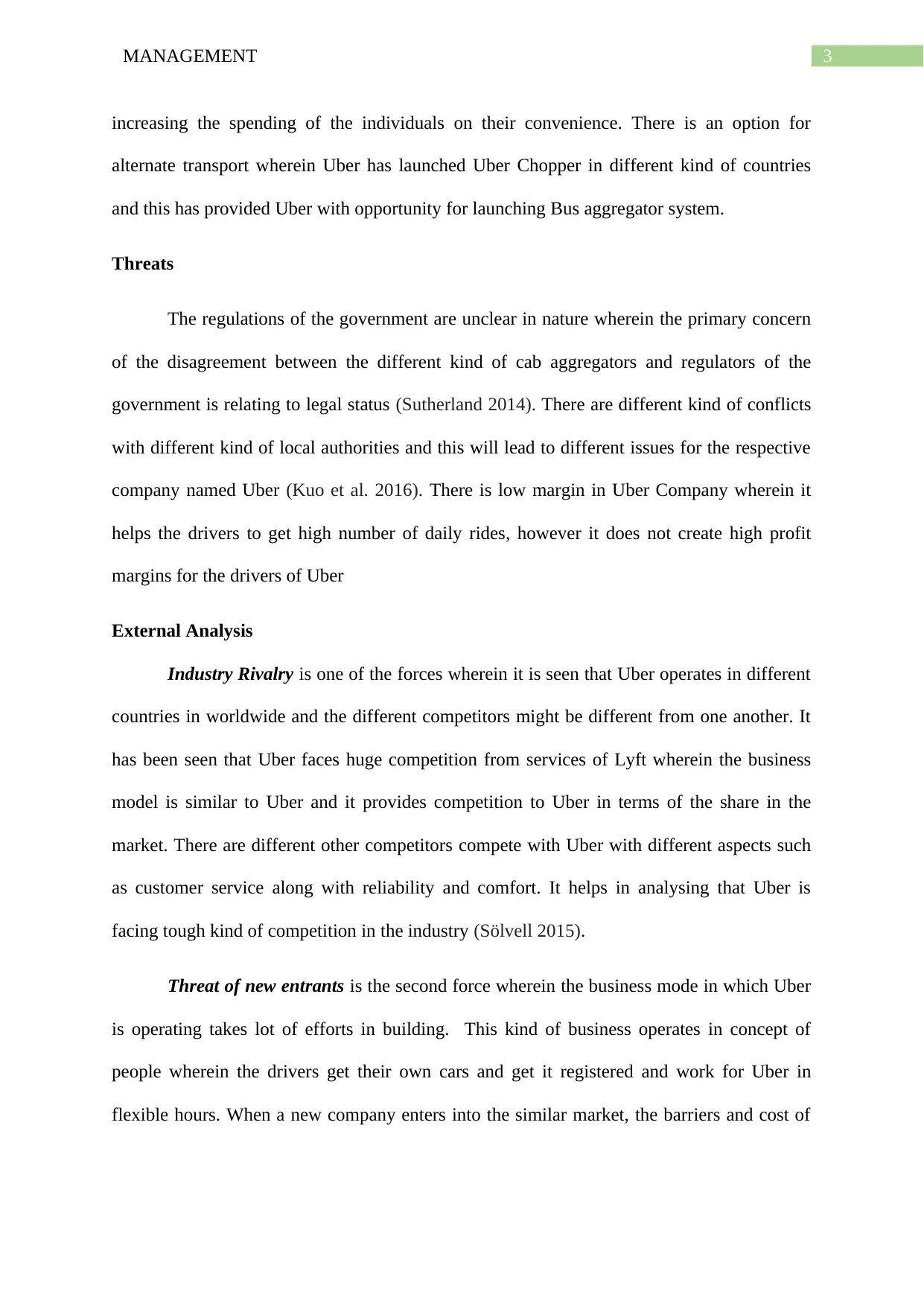
3MANAGEMENT
increasing the spending of the individuals on their convenience. There is an option for
alternate transport wherein Uber has launched Uber Chopper in different kind of countries
and this has provided Uber with opportunity for launching Bus aggregator system.
Threats
The regulations of the government are unclear in nature wherein the primary concern
of the disagreement between the different kind of cab aggregators and regulators of the
government is relating to legal status (Sutherland 2014). There are different kind of conflicts
with different kind of local authorities and this will lead to different issues for the respective
company named Uber (Kuo et al. 2016). There is low margin in Uber Company wherein it
helps the drivers to get high number of daily rides, however it does not create high profit
margins for the drivers of Uber
External Analysis
Industry Rivalry is one of the forces wherein it is seen that Uber operates in different
countries in worldwide and the different competitors might be different from one another. It
has been seen that Uber faces huge competition from services of Lyft wherein the business
model is similar to Uber and it provides competition to Uber in terms of the share in the
market. There are different other competitors compete with Uber with different aspects such
as customer service along with reliability and comfort. It helps in analysing that Uber is
facing tough kind of competition in the industry (Sölvell 2015).
Threat of new entrants is the second force wherein the business mode in which Uber
is operating takes lot of efforts in building. This kind of business operates in concept of
people wherein the drivers get their own cars and get it registered and work for Uber in
flexible hours. When a new company enters into the similar market, the barriers and cost of
increasing the spending of the individuals on their convenience. There is an option for
alternate transport wherein Uber has launched Uber Chopper in different kind of countries
and this has provided Uber with opportunity for launching Bus aggregator system.
Threats
The regulations of the government are unclear in nature wherein the primary concern
of the disagreement between the different kind of cab aggregators and regulators of the
government is relating to legal status (Sutherland 2014). There are different kind of conflicts
with different kind of local authorities and this will lead to different issues for the respective
company named Uber (Kuo et al. 2016). There is low margin in Uber Company wherein it
helps the drivers to get high number of daily rides, however it does not create high profit
margins for the drivers of Uber
External Analysis
Industry Rivalry is one of the forces wherein it is seen that Uber operates in different
countries in worldwide and the different competitors might be different from one another. It
has been seen that Uber faces huge competition from services of Lyft wherein the business
model is similar to Uber and it provides competition to Uber in terms of the share in the
market. There are different other competitors compete with Uber with different aspects such
as customer service along with reliability and comfort. It helps in analysing that Uber is
facing tough kind of competition in the industry (Sölvell 2015).
Threat of new entrants is the second force wherein the business mode in which Uber
is operating takes lot of efforts in building. This kind of business operates in concept of
people wherein the drivers get their own cars and get it registered and work for Uber in
flexible hours. When a new company enters into the similar market, the barriers and cost of
Paraphrase This Document
Need a fresh take? Get an instant paraphrase of this document with our AI Paraphraser
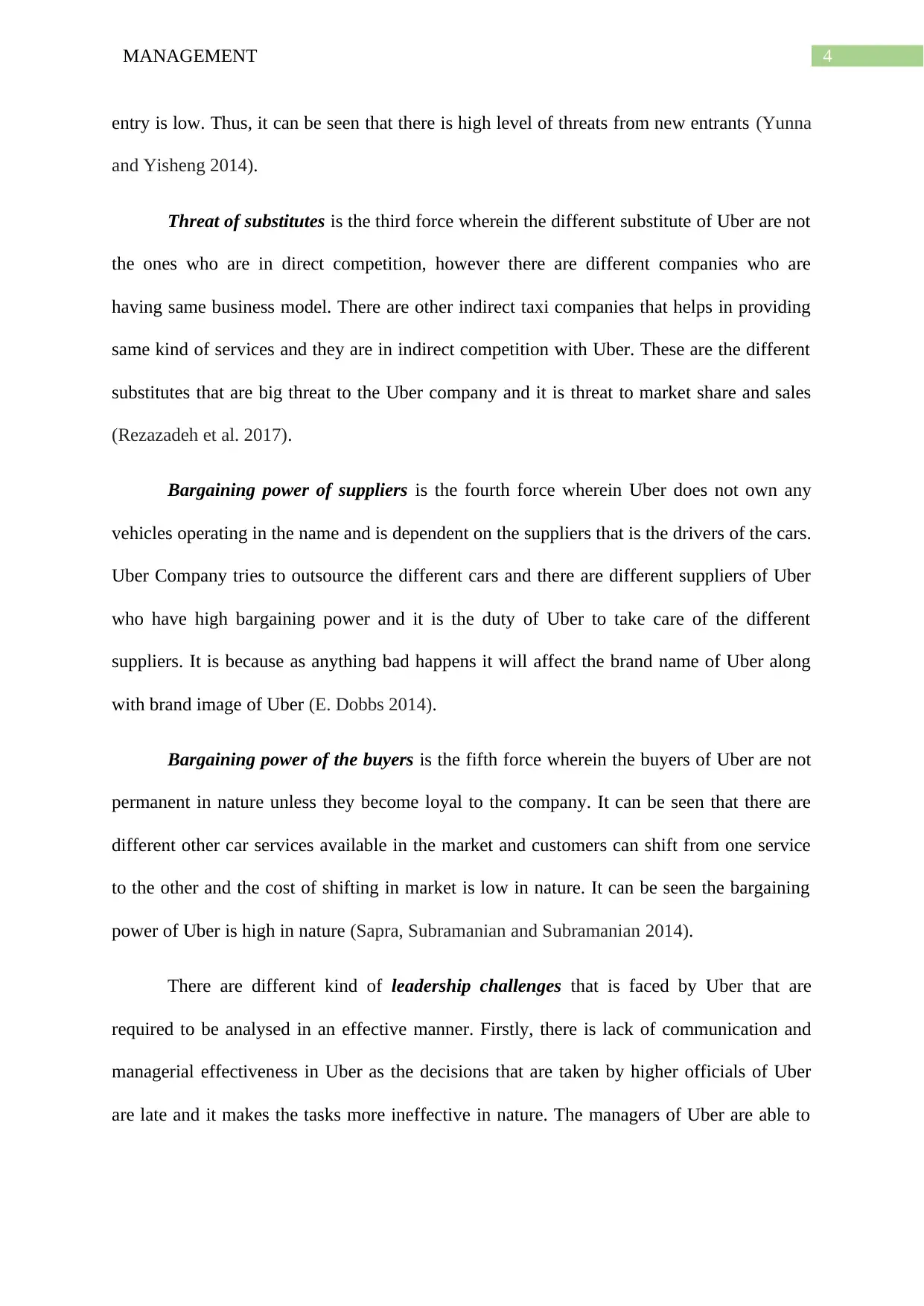
4MANAGEMENT
entry is low. Thus, it can be seen that there is high level of threats from new entrants (Yunna
and Yisheng 2014).
Threat of substitutes is the third force wherein the different substitute of Uber are not
the ones who are in direct competition, however there are different companies who are
having same business model. There are other indirect taxi companies that helps in providing
same kind of services and they are in indirect competition with Uber. These are the different
substitutes that are big threat to the Uber company and it is threat to market share and sales
(Rezazadeh et al. 2017).
Bargaining power of suppliers is the fourth force wherein Uber does not own any
vehicles operating in the name and is dependent on the suppliers that is the drivers of the cars.
Uber Company tries to outsource the different cars and there are different suppliers of Uber
who have high bargaining power and it is the duty of Uber to take care of the different
suppliers. It is because as anything bad happens it will affect the brand name of Uber along
with brand image of Uber (E. Dobbs 2014).
Bargaining power of the buyers is the fifth force wherein the buyers of Uber are not
permanent in nature unless they become loyal to the company. It can be seen that there are
different other car services available in the market and customers can shift from one service
to the other and the cost of shifting in market is low in nature. It can be seen the bargaining
power of Uber is high in nature (Sapra, Subramanian and Subramanian 2014).
There are different kind of leadership challenges that is faced by Uber that are
required to be analysed in an effective manner. Firstly, there is lack of communication and
managerial effectiveness in Uber as the decisions that are taken by higher officials of Uber
are late and it makes the tasks more ineffective in nature. The managers of Uber are able to
entry is low. Thus, it can be seen that there is high level of threats from new entrants (Yunna
and Yisheng 2014).
Threat of substitutes is the third force wherein the different substitute of Uber are not
the ones who are in direct competition, however there are different companies who are
having same business model. There are other indirect taxi companies that helps in providing
same kind of services and they are in indirect competition with Uber. These are the different
substitutes that are big threat to the Uber company and it is threat to market share and sales
(Rezazadeh et al. 2017).
Bargaining power of suppliers is the fourth force wherein Uber does not own any
vehicles operating in the name and is dependent on the suppliers that is the drivers of the cars.
Uber Company tries to outsource the different cars and there are different suppliers of Uber
who have high bargaining power and it is the duty of Uber to take care of the different
suppliers. It is because as anything bad happens it will affect the brand name of Uber along
with brand image of Uber (E. Dobbs 2014).
Bargaining power of the buyers is the fifth force wherein the buyers of Uber are not
permanent in nature unless they become loyal to the company. It can be seen that there are
different other car services available in the market and customers can shift from one service
to the other and the cost of shifting in market is low in nature. It can be seen the bargaining
power of Uber is high in nature (Sapra, Subramanian and Subramanian 2014).
There are different kind of leadership challenges that is faced by Uber that are
required to be analysed in an effective manner. Firstly, there is lack of communication and
managerial effectiveness in Uber as the decisions that are taken by higher officials of Uber
are late and it makes the tasks more ineffective in nature. The managers of Uber are able to

5MANAGEMENT
adjust with the role effectively and managers are not supportive in understanding the queries
of the driver partners.
Secondly, guiding change is the other challenge of Uber wherein the leaders are not
able to understand and lead change effectively. The leaders of the Uber Company are not able
to lead to changes in an effective manner. The leaders do not set goals in the initial stage and
they implement strategies after they are facing huge competition in the market (Yan, Xia and
Bao 2015).
Lastly, leaders of Uber Company are not able to manage the internal stakeholders
along with politics as they fail in managing relationships in an effectual manner. There is no
such managerial support from higher authority and this creates miscommunication among
employees (Quitzow et al. 2014).
From the above figure, it can be analysed that proper leadership is required to be
maintained by Uber Company in overcoming such challenges in an effectual manner. The
different analysis is required to be done that are as follows:
The leaders need to set goals and they has to be proactive in nature as this will help
the company in meeting the different deadlines. This will help the company in gaining
competitive advantage with the implementation of transformational leadership style (Takata
2016). Secondly, the leaders need to delegate tasks in an effective manner wherein all the
driver partners have to be provided with different facilities and understand their view point.
The transformational kind of leadership will help in solving the different issues
among the leaders and the employees. It is required to maximize the unique value in
comparison to the other competitors in the market wherein the company will prioritize their
organizational goals. This will help the company in increasing the efficiency effectiveness
and performance of business.
adjust with the role effectively and managers are not supportive in understanding the queries
of the driver partners.
Secondly, guiding change is the other challenge of Uber wherein the leaders are not
able to understand and lead change effectively. The leaders of the Uber Company are not able
to lead to changes in an effective manner. The leaders do not set goals in the initial stage and
they implement strategies after they are facing huge competition in the market (Yan, Xia and
Bao 2015).
Lastly, leaders of Uber Company are not able to manage the internal stakeholders
along with politics as they fail in managing relationships in an effectual manner. There is no
such managerial support from higher authority and this creates miscommunication among
employees (Quitzow et al. 2014).
From the above figure, it can be analysed that proper leadership is required to be
maintained by Uber Company in overcoming such challenges in an effectual manner. The
different analysis is required to be done that are as follows:
The leaders need to set goals and they has to be proactive in nature as this will help
the company in meeting the different deadlines. This will help the company in gaining
competitive advantage with the implementation of transformational leadership style (Takata
2016). Secondly, the leaders need to delegate tasks in an effective manner wherein all the
driver partners have to be provided with different facilities and understand their view point.
The transformational kind of leadership will help in solving the different issues
among the leaders and the employees. It is required to maximize the unique value in
comparison to the other competitors in the market wherein the company will prioritize their
organizational goals. This will help the company in increasing the efficiency effectiveness
and performance of business.
⊘ This is a preview!⊘
Do you want full access?
Subscribe today to unlock all pages.

Trusted by 1+ million students worldwide
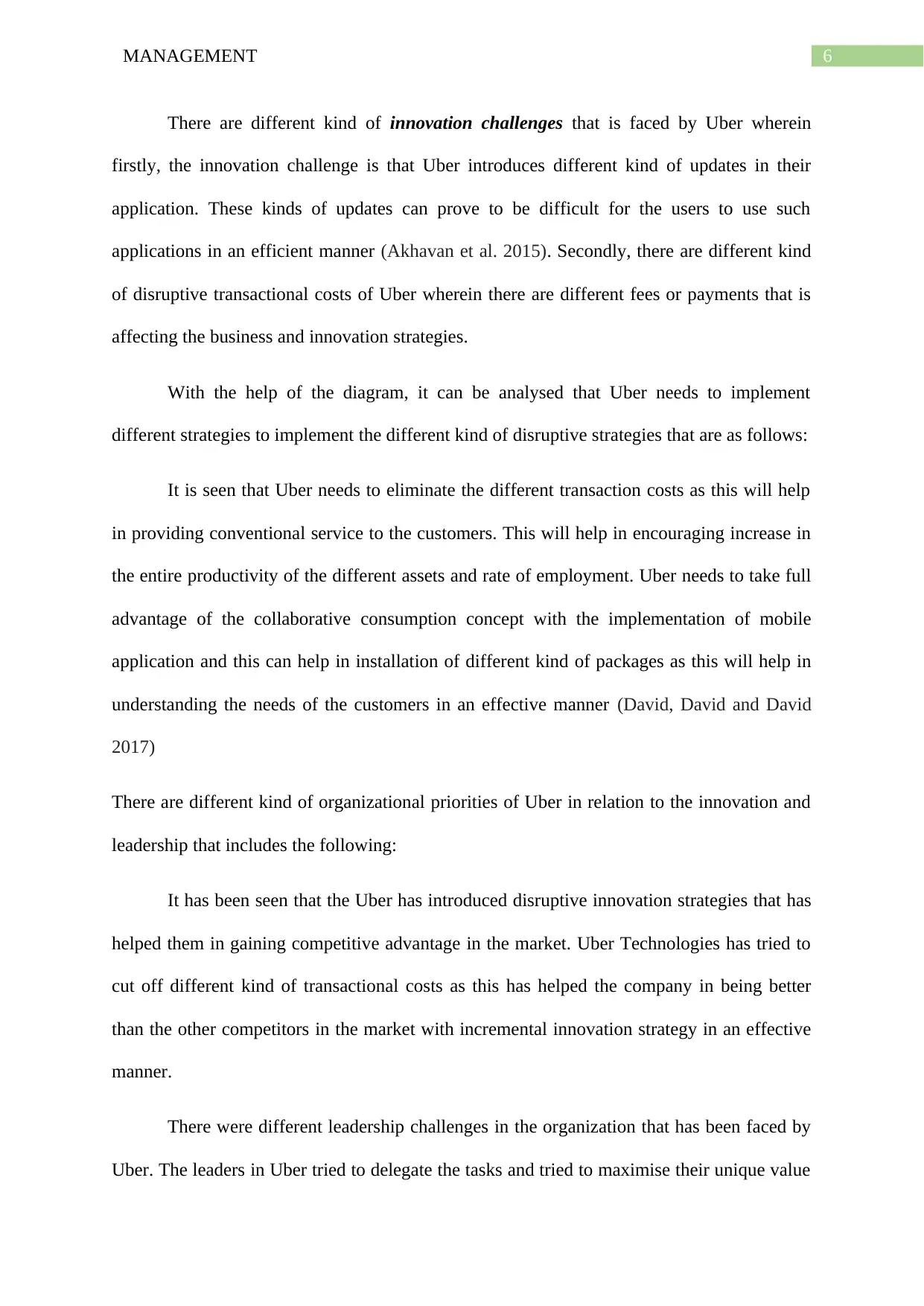
6MANAGEMENT
There are different kind of innovation challenges that is faced by Uber wherein
firstly, the innovation challenge is that Uber introduces different kind of updates in their
application. These kinds of updates can prove to be difficult for the users to use such
applications in an efficient manner (Akhavan et al. 2015). Secondly, there are different kind
of disruptive transactional costs of Uber wherein there are different fees or payments that is
affecting the business and innovation strategies.
With the help of the diagram, it can be analysed that Uber needs to implement
different strategies to implement the different kind of disruptive strategies that are as follows:
It is seen that Uber needs to eliminate the different transaction costs as this will help
in providing conventional service to the customers. This will help in encouraging increase in
the entire productivity of the different assets and rate of employment. Uber needs to take full
advantage of the collaborative consumption concept with the implementation of mobile
application and this can help in installation of different kind of packages as this will help in
understanding the needs of the customers in an effective manner (David, David and David
2017)
There are different kind of organizational priorities of Uber in relation to the innovation and
leadership that includes the following:
It has been seen that the Uber has introduced disruptive innovation strategies that has
helped them in gaining competitive advantage in the market. Uber Technologies has tried to
cut off different kind of transactional costs as this has helped the company in being better
than the other competitors in the market with incremental innovation strategy in an effective
manner.
There were different leadership challenges in the organization that has been faced by
Uber. The leaders in Uber tried to delegate the tasks and tried to maximise their unique value
There are different kind of innovation challenges that is faced by Uber wherein
firstly, the innovation challenge is that Uber introduces different kind of updates in their
application. These kinds of updates can prove to be difficult for the users to use such
applications in an efficient manner (Akhavan et al. 2015). Secondly, there are different kind
of disruptive transactional costs of Uber wherein there are different fees or payments that is
affecting the business and innovation strategies.
With the help of the diagram, it can be analysed that Uber needs to implement
different strategies to implement the different kind of disruptive strategies that are as follows:
It is seen that Uber needs to eliminate the different transaction costs as this will help
in providing conventional service to the customers. This will help in encouraging increase in
the entire productivity of the different assets and rate of employment. Uber needs to take full
advantage of the collaborative consumption concept with the implementation of mobile
application and this can help in installation of different kind of packages as this will help in
understanding the needs of the customers in an effective manner (David, David and David
2017)
There are different kind of organizational priorities of Uber in relation to the innovation and
leadership that includes the following:
It has been seen that the Uber has introduced disruptive innovation strategies that has
helped them in gaining competitive advantage in the market. Uber Technologies has tried to
cut off different kind of transactional costs as this has helped the company in being better
than the other competitors in the market with incremental innovation strategy in an effective
manner.
There were different leadership challenges in the organization that has been faced by
Uber. The leaders in Uber tried to delegate the tasks and tried to maximise their unique value
Paraphrase This Document
Need a fresh take? Get an instant paraphrase of this document with our AI Paraphraser
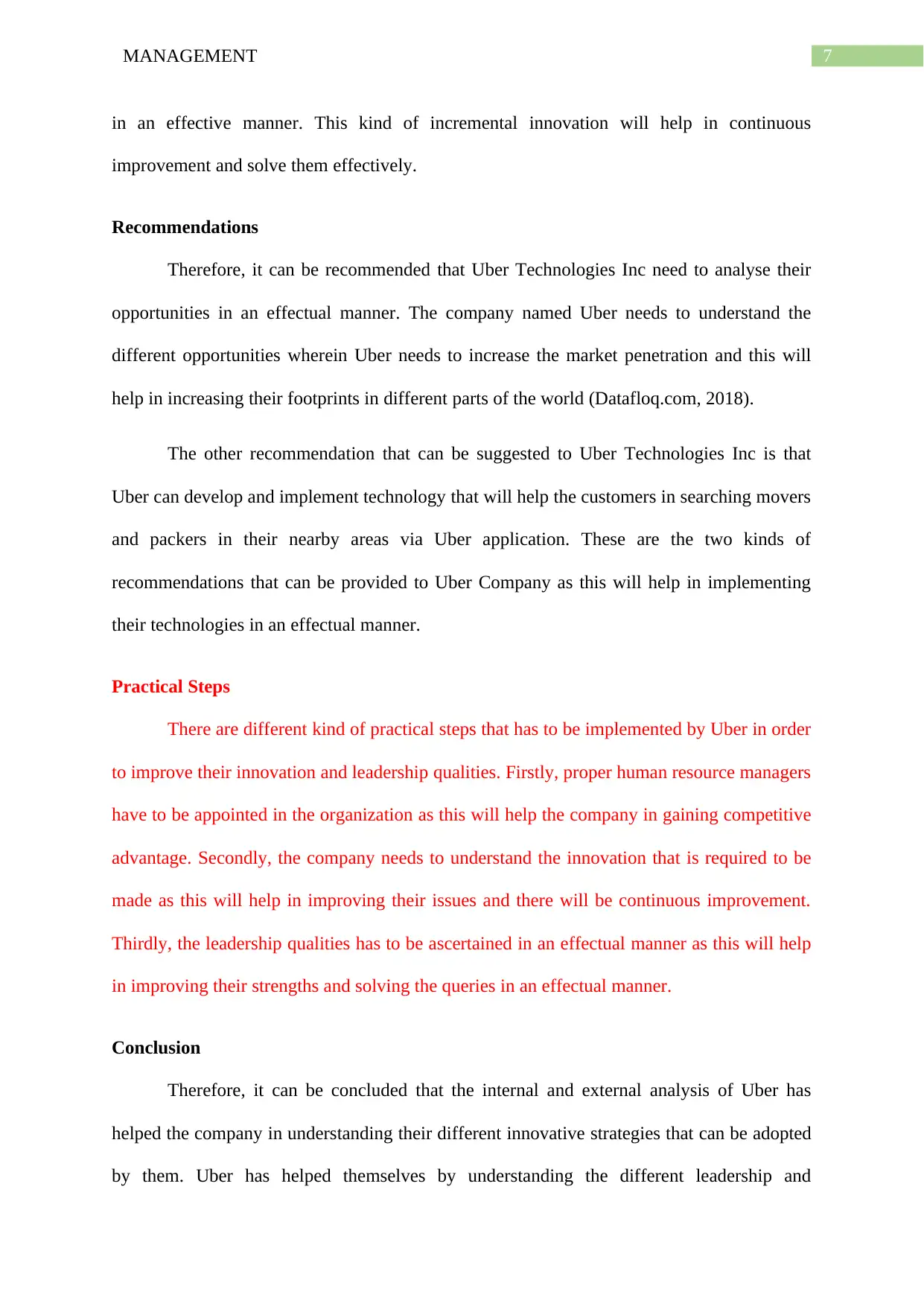
7MANAGEMENT
in an effective manner. This kind of incremental innovation will help in continuous
improvement and solve them effectively.
Recommendations
Therefore, it can be recommended that Uber Technologies Inc need to analyse their
opportunities in an effectual manner. The company named Uber needs to understand the
different opportunities wherein Uber needs to increase the market penetration and this will
help in increasing their footprints in different parts of the world (Datafloq.com, 2018).
The other recommendation that can be suggested to Uber Technologies Inc is that
Uber can develop and implement technology that will help the customers in searching movers
and packers in their nearby areas via Uber application. These are the two kinds of
recommendations that can be provided to Uber Company as this will help in implementing
their technologies in an effectual manner.
Practical Steps
There are different kind of practical steps that has to be implemented by Uber in order
to improve their innovation and leadership qualities. Firstly, proper human resource managers
have to be appointed in the organization as this will help the company in gaining competitive
advantage. Secondly, the company needs to understand the innovation that is required to be
made as this will help in improving their issues and there will be continuous improvement.
Thirdly, the leadership qualities has to be ascertained in an effectual manner as this will help
in improving their strengths and solving the queries in an effectual manner.
Conclusion
Therefore, it can be concluded that the internal and external analysis of Uber has
helped the company in understanding their different innovative strategies that can be adopted
by them. Uber has helped themselves by understanding the different leadership and
in an effective manner. This kind of incremental innovation will help in continuous
improvement and solve them effectively.
Recommendations
Therefore, it can be recommended that Uber Technologies Inc need to analyse their
opportunities in an effectual manner. The company named Uber needs to understand the
different opportunities wherein Uber needs to increase the market penetration and this will
help in increasing their footprints in different parts of the world (Datafloq.com, 2018).
The other recommendation that can be suggested to Uber Technologies Inc is that
Uber can develop and implement technology that will help the customers in searching movers
and packers in their nearby areas via Uber application. These are the two kinds of
recommendations that can be provided to Uber Company as this will help in implementing
their technologies in an effectual manner.
Practical Steps
There are different kind of practical steps that has to be implemented by Uber in order
to improve their innovation and leadership qualities. Firstly, proper human resource managers
have to be appointed in the organization as this will help the company in gaining competitive
advantage. Secondly, the company needs to understand the innovation that is required to be
made as this will help in improving their issues and there will be continuous improvement.
Thirdly, the leadership qualities has to be ascertained in an effectual manner as this will help
in improving their strengths and solving the queries in an effectual manner.
Conclusion
Therefore, it can be concluded that the internal and external analysis of Uber has
helped the company in understanding their different innovative strategies that can be adopted
by them. Uber has helped themselves by understanding the different leadership and
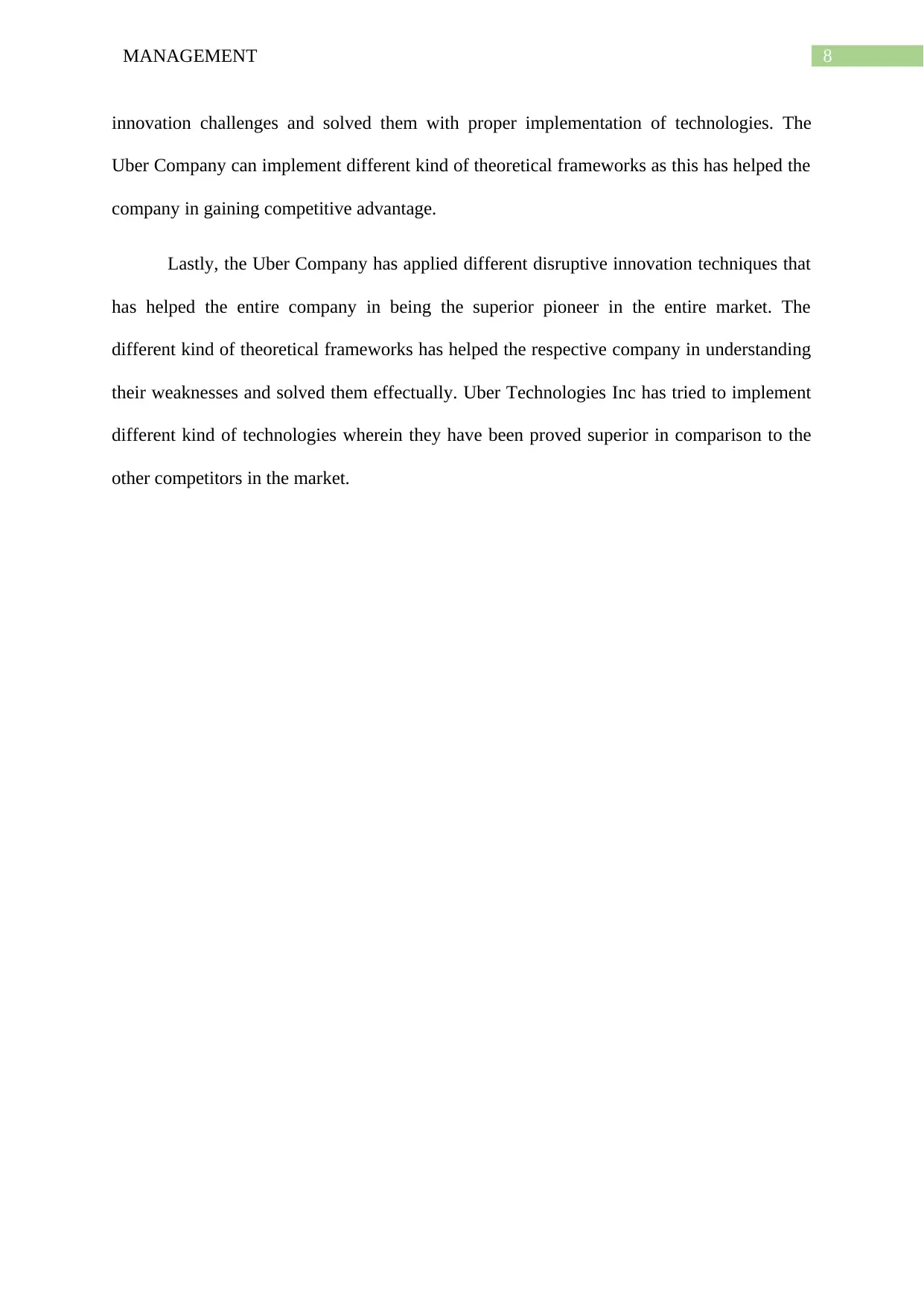
8MANAGEMENT
innovation challenges and solved them with proper implementation of technologies. The
Uber Company can implement different kind of theoretical frameworks as this has helped the
company in gaining competitive advantage.
Lastly, the Uber Company has applied different disruptive innovation techniques that
has helped the entire company in being the superior pioneer in the entire market. The
different kind of theoretical frameworks has helped the respective company in understanding
their weaknesses and solved them effectually. Uber Technologies Inc has tried to implement
different kind of technologies wherein they have been proved superior in comparison to the
other competitors in the market.
innovation challenges and solved them with proper implementation of technologies. The
Uber Company can implement different kind of theoretical frameworks as this has helped the
company in gaining competitive advantage.
Lastly, the Uber Company has applied different disruptive innovation techniques that
has helped the entire company in being the superior pioneer in the entire market. The
different kind of theoretical frameworks has helped the respective company in understanding
their weaknesses and solved them effectually. Uber Technologies Inc has tried to implement
different kind of technologies wherein they have been proved superior in comparison to the
other competitors in the market.
⊘ This is a preview!⊘
Do you want full access?
Subscribe today to unlock all pages.

Trusted by 1+ million students worldwide
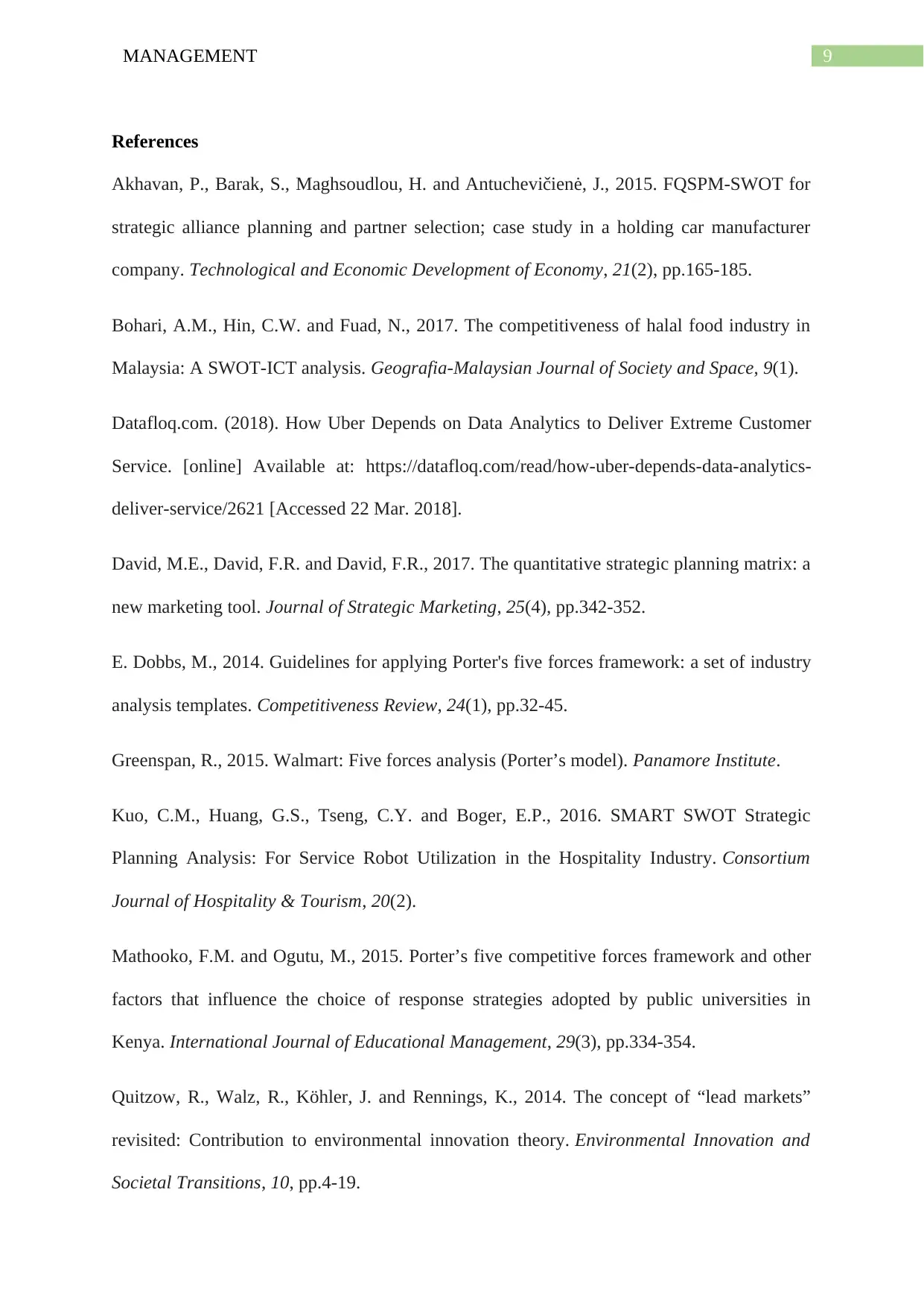
9MANAGEMENT
References
Akhavan, P., Barak, S., Maghsoudlou, H. and Antuchevičienė, J., 2015. FQSPM-SWOT for
strategic alliance planning and partner selection; case study in a holding car manufacturer
company. Technological and Economic Development of Economy, 21(2), pp.165-185.
Bohari, A.M., Hin, C.W. and Fuad, N., 2017. The competitiveness of halal food industry in
Malaysia: A SWOT-ICT analysis. Geografia-Malaysian Journal of Society and Space, 9(1).
Datafloq.com. (2018). How Uber Depends on Data Analytics to Deliver Extreme Customer
Service. [online] Available at: https://datafloq.com/read/how-uber-depends-data-analytics-
deliver-service/2621 [Accessed 22 Mar. 2018].
David, M.E., David, F.R. and David, F.R., 2017. The quantitative strategic planning matrix: a
new marketing tool. Journal of Strategic Marketing, 25(4), pp.342-352.
E. Dobbs, M., 2014. Guidelines for applying Porter's five forces framework: a set of industry
analysis templates. Competitiveness Review, 24(1), pp.32-45.
Greenspan, R., 2015. Walmart: Five forces analysis (Porter’s model). Panamore Institute.
Kuo, C.M., Huang, G.S., Tseng, C.Y. and Boger, E.P., 2016. SMART SWOT Strategic
Planning Analysis: For Service Robot Utilization in the Hospitality Industry. Consortium
Journal of Hospitality & Tourism, 20(2).
Mathooko, F.M. and Ogutu, M., 2015. Porter’s five competitive forces framework and other
factors that influence the choice of response strategies adopted by public universities in
Kenya. International Journal of Educational Management, 29(3), pp.334-354.
Quitzow, R., Walz, R., Köhler, J. and Rennings, K., 2014. The concept of “lead markets”
revisited: Contribution to environmental innovation theory. Environmental Innovation and
Societal Transitions, 10, pp.4-19.
References
Akhavan, P., Barak, S., Maghsoudlou, H. and Antuchevičienė, J., 2015. FQSPM-SWOT for
strategic alliance planning and partner selection; case study in a holding car manufacturer
company. Technological and Economic Development of Economy, 21(2), pp.165-185.
Bohari, A.M., Hin, C.W. and Fuad, N., 2017. The competitiveness of halal food industry in
Malaysia: A SWOT-ICT analysis. Geografia-Malaysian Journal of Society and Space, 9(1).
Datafloq.com. (2018). How Uber Depends on Data Analytics to Deliver Extreme Customer
Service. [online] Available at: https://datafloq.com/read/how-uber-depends-data-analytics-
deliver-service/2621 [Accessed 22 Mar. 2018].
David, M.E., David, F.R. and David, F.R., 2017. The quantitative strategic planning matrix: a
new marketing tool. Journal of Strategic Marketing, 25(4), pp.342-352.
E. Dobbs, M., 2014. Guidelines for applying Porter's five forces framework: a set of industry
analysis templates. Competitiveness Review, 24(1), pp.32-45.
Greenspan, R., 2015. Walmart: Five forces analysis (Porter’s model). Panamore Institute.
Kuo, C.M., Huang, G.S., Tseng, C.Y. and Boger, E.P., 2016. SMART SWOT Strategic
Planning Analysis: For Service Robot Utilization in the Hospitality Industry. Consortium
Journal of Hospitality & Tourism, 20(2).
Mathooko, F.M. and Ogutu, M., 2015. Porter’s five competitive forces framework and other
factors that influence the choice of response strategies adopted by public universities in
Kenya. International Journal of Educational Management, 29(3), pp.334-354.
Quitzow, R., Walz, R., Köhler, J. and Rennings, K., 2014. The concept of “lead markets”
revisited: Contribution to environmental innovation theory. Environmental Innovation and
Societal Transitions, 10, pp.4-19.
Paraphrase This Document
Need a fresh take? Get an instant paraphrase of this document with our AI Paraphraser
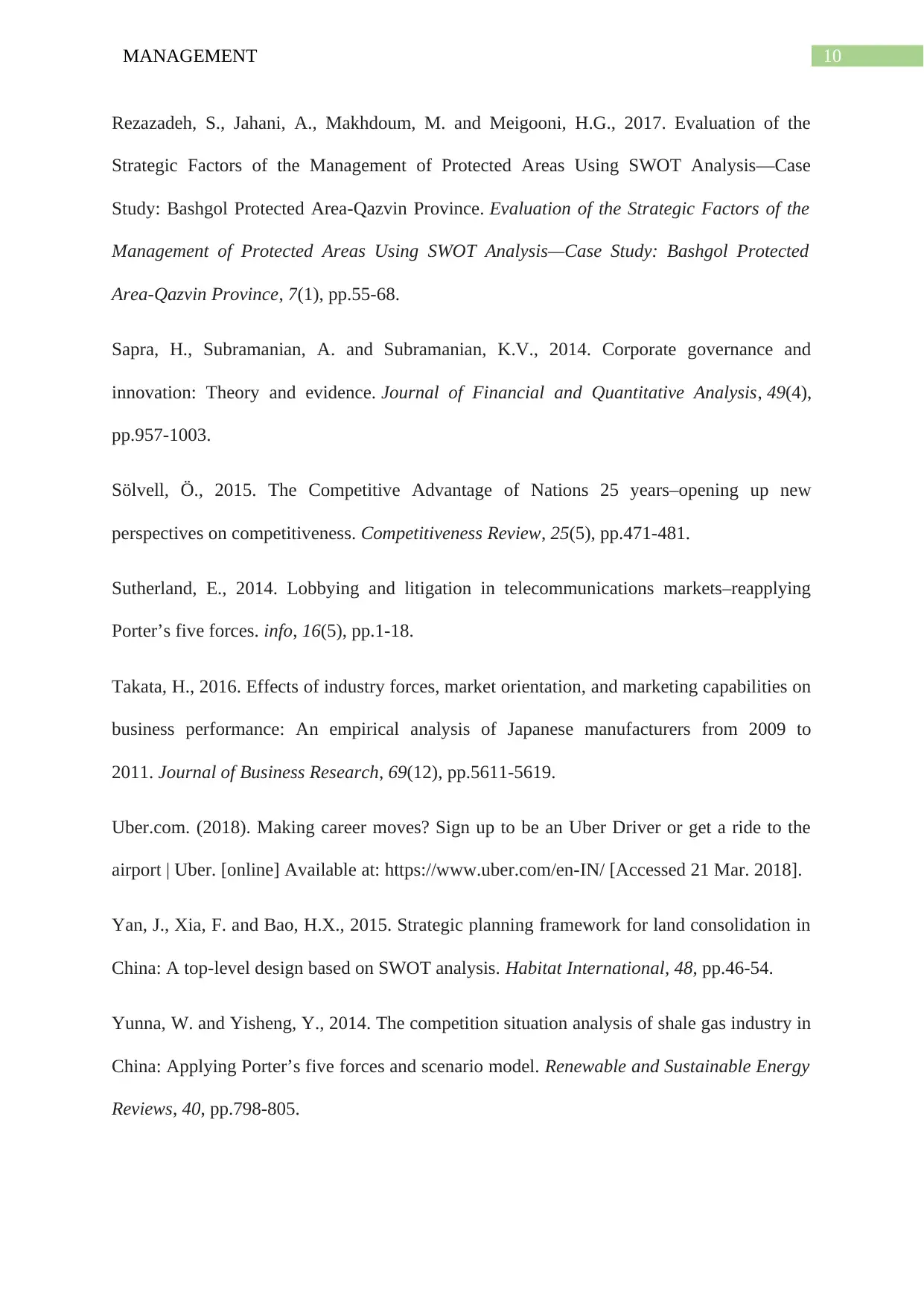
10MANAGEMENT
Rezazadeh, S., Jahani, A., Makhdoum, M. and Meigooni, H.G., 2017. Evaluation of the
Strategic Factors of the Management of Protected Areas Using SWOT Analysis—Case
Study: Bashgol Protected Area-Qazvin Province. Evaluation of the Strategic Factors of the
Management of Protected Areas Using SWOT Analysis—Case Study: Bashgol Protected
Area-Qazvin Province, 7(1), pp.55-68.
Sapra, H., Subramanian, A. and Subramanian, K.V., 2014. Corporate governance and
innovation: Theory and evidence. Journal of Financial and Quantitative Analysis, 49(4),
pp.957-1003.
Sölvell, Ö., 2015. The Competitive Advantage of Nations 25 years–opening up new
perspectives on competitiveness. Competitiveness Review, 25(5), pp.471-481.
Sutherland, E., 2014. Lobbying and litigation in telecommunications markets–reapplying
Porter’s five forces. info, 16(5), pp.1-18.
Takata, H., 2016. Effects of industry forces, market orientation, and marketing capabilities on
business performance: An empirical analysis of Japanese manufacturers from 2009 to
2011. Journal of Business Research, 69(12), pp.5611-5619.
Uber.com. (2018). Making career moves? Sign up to be an Uber Driver or get a ride to the
airport | Uber. [online] Available at: https://www.uber.com/en-IN/ [Accessed 21 Mar. 2018].
Yan, J., Xia, F. and Bao, H.X., 2015. Strategic planning framework for land consolidation in
China: A top-level design based on SWOT analysis. Habitat International, 48, pp.46-54.
Yunna, W. and Yisheng, Y., 2014. The competition situation analysis of shale gas industry in
China: Applying Porter’s five forces and scenario model. Renewable and Sustainable Energy
Reviews, 40, pp.798-805.
Rezazadeh, S., Jahani, A., Makhdoum, M. and Meigooni, H.G., 2017. Evaluation of the
Strategic Factors of the Management of Protected Areas Using SWOT Analysis—Case
Study: Bashgol Protected Area-Qazvin Province. Evaluation of the Strategic Factors of the
Management of Protected Areas Using SWOT Analysis—Case Study: Bashgol Protected
Area-Qazvin Province, 7(1), pp.55-68.
Sapra, H., Subramanian, A. and Subramanian, K.V., 2014. Corporate governance and
innovation: Theory and evidence. Journal of Financial and Quantitative Analysis, 49(4),
pp.957-1003.
Sölvell, Ö., 2015. The Competitive Advantage of Nations 25 years–opening up new
perspectives on competitiveness. Competitiveness Review, 25(5), pp.471-481.
Sutherland, E., 2014. Lobbying and litigation in telecommunications markets–reapplying
Porter’s five forces. info, 16(5), pp.1-18.
Takata, H., 2016. Effects of industry forces, market orientation, and marketing capabilities on
business performance: An empirical analysis of Japanese manufacturers from 2009 to
2011. Journal of Business Research, 69(12), pp.5611-5619.
Uber.com. (2018). Making career moves? Sign up to be an Uber Driver or get a ride to the
airport | Uber. [online] Available at: https://www.uber.com/en-IN/ [Accessed 21 Mar. 2018].
Yan, J., Xia, F. and Bao, H.X., 2015. Strategic planning framework for land consolidation in
China: A top-level design based on SWOT analysis. Habitat International, 48, pp.46-54.
Yunna, W. and Yisheng, Y., 2014. The competition situation analysis of shale gas industry in
China: Applying Porter’s five forces and scenario model. Renewable and Sustainable Energy
Reviews, 40, pp.798-805.

11MANAGEMENT
Appendix
Appendices 1
Figure 1: Theoretical Framework
(Source: David, David and David 2017)
Appendices 2
Figure 2: Theoretical model of innovation
(Source: David, David and David 2017)
Appendix
Appendices 1
Figure 1: Theoretical Framework
(Source: David, David and David 2017)
Appendices 2
Figure 2: Theoretical model of innovation
(Source: David, David and David 2017)
⊘ This is a preview!⊘
Do you want full access?
Subscribe today to unlock all pages.

Trusted by 1+ million students worldwide
1 out of 12
Related Documents
Your All-in-One AI-Powered Toolkit for Academic Success.
+13062052269
info@desklib.com
Available 24*7 on WhatsApp / Email
![[object Object]](/_next/static/media/star-bottom.7253800d.svg)
Unlock your academic potential
Copyright © 2020–2025 A2Z Services. All Rights Reserved. Developed and managed by ZUCOL.





